Toshiba KIRAbook Ultrabook Review
by Dustin Sklavos on May 9, 2013 12:01 AM ESTDisplay Quality
The Toshiba KIRAbook's claim to fame is its 2560x1440 13.3" IPS display, and that display really is a beauty. Viewing angles are excellent as one would expect, but there are two very minor issues. First, response time is good, but not great, and there's minor ghosting when dragging a window or the start screen. There's also backlight bleed on the edges of the display that's fairly typical of an edge-lit panel. Neither of these are dealbreakers and I'd still very easily take the KIRAbook's display over just about any competing notebook's, including the 1080p IPS stunner in the Dell XPS 13.
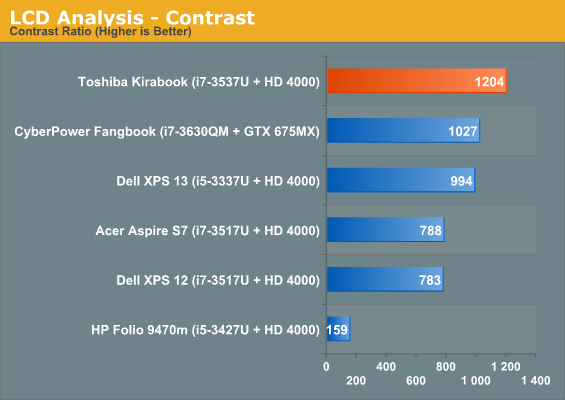
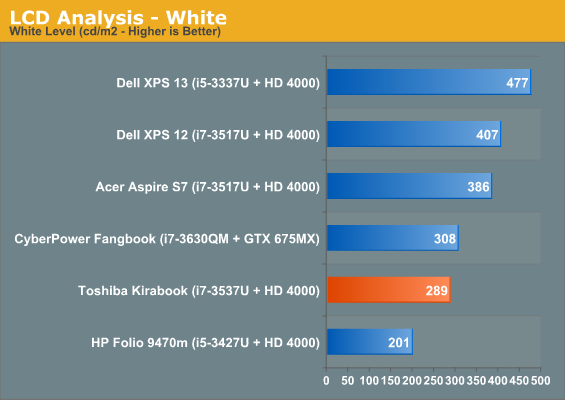
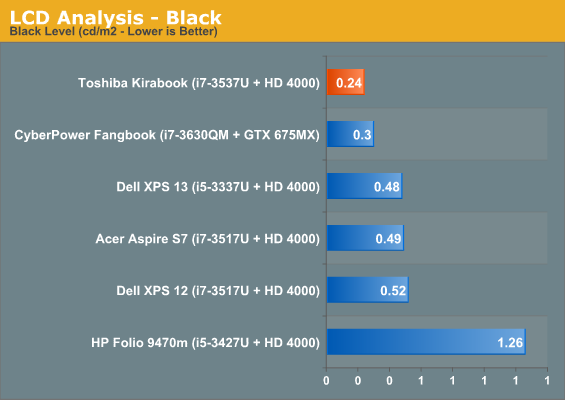
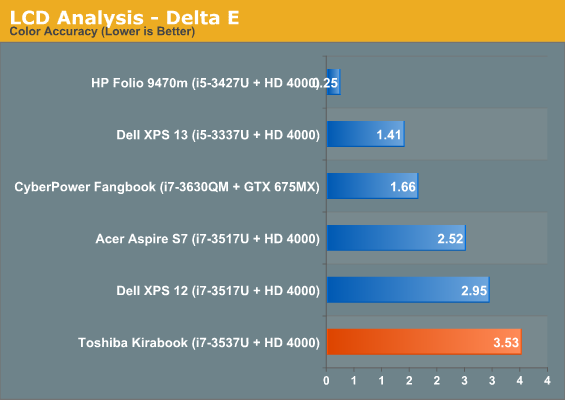
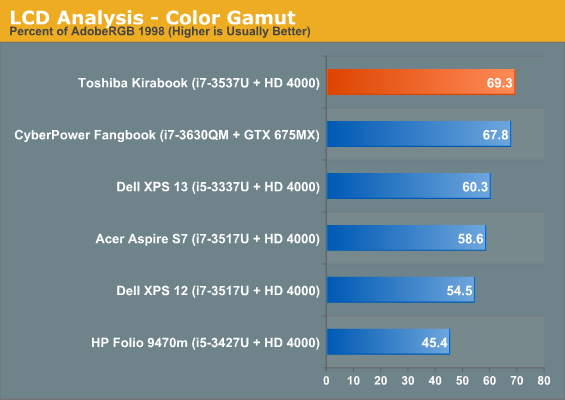
Everything about the KIRAbook's display screams quality except the measured delta-E, but in practice I found the display color to be plenty accurate and certainly worthy of the packed-in Adobe Photoshop Elements. Color gamut's quite good, brightness is beautiful without being excessive, and black levels are stellar. It's difficult not to be impressed with this panel.
Battery Life
When dealing with a high-resolution IPS panel, especially one as bright as the KIRAbook's, it can be hard to predict just how the battery life will play out. That's compounded by the fact that space for battery cells inside an ultrabook is always at a premium. The 52Wh integrated battery is at least slightly above average, though.
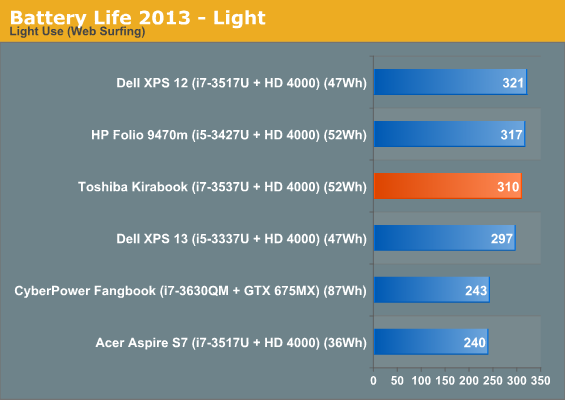
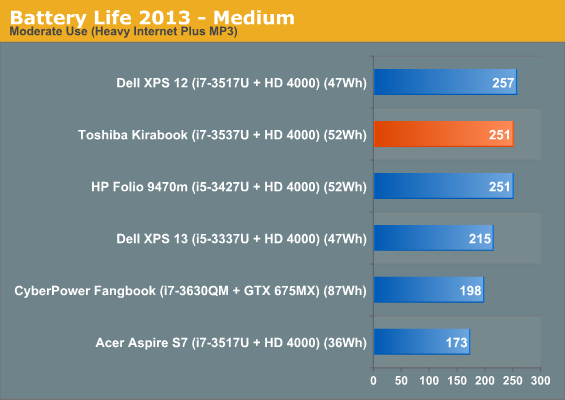
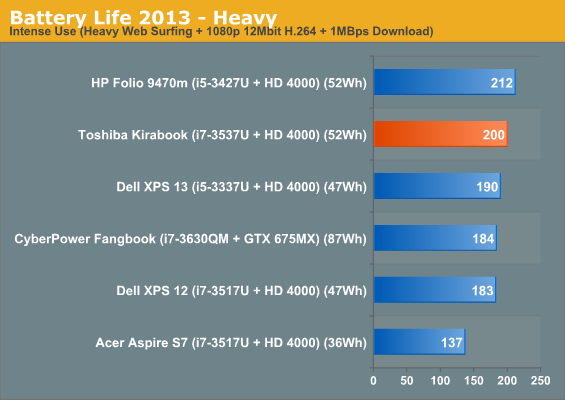
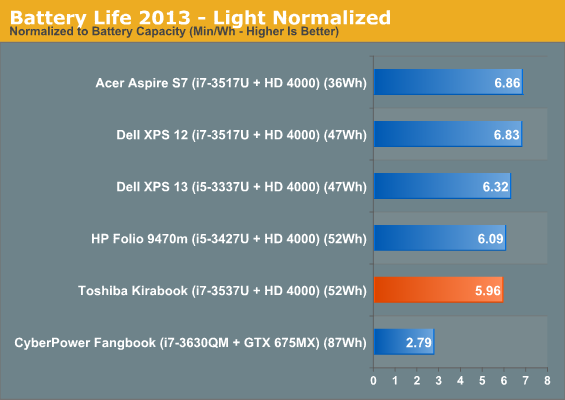
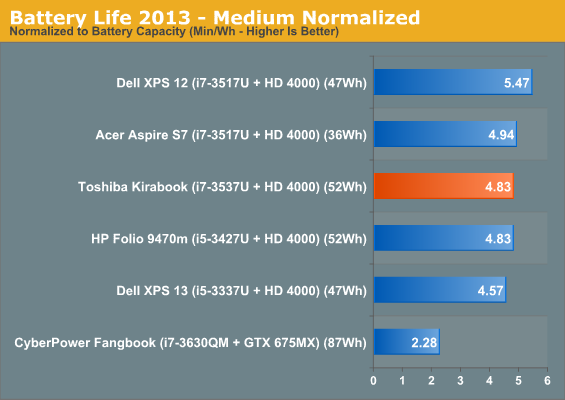
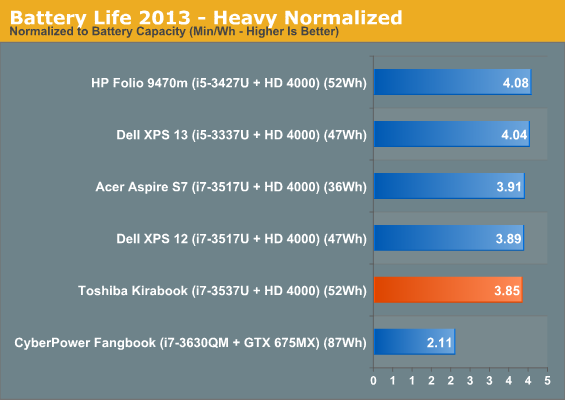
In broader terms, the KIRAbook produces battery life competitive with other ultrabooks in its class. When you normalize it, things look slightly worse, but not substantially so. There's clearly a very minor trade-off taking place to get that better display quality. That trade-off is largely negated by the slightly larger battery and substantially superior panel.
Heat and Noise
Toshiba made a big deal about the KIRAbook's cooling mechanism, but in practice this cooling system is essentially identical to the one in the Portege Z835. That worked out great for the Portege when we reviewed it, which featured a turbo-free Sandy Bridge low-voltage Core i3, but the KIRAbook has a harder time dealing with the horsepower of the i7-3537U.
Thermals under load are quite good, but noise is much less so. Idle noise is stellar; the KIRAbook is basically inaudible. Sustained load hitting the CPU causes the fan to spin up gradually, and again I lament the bottom-intake fan. During Cinebench R11.5 testing the i7-3537U spent most of its time at 2.3GHz, and it did take a good minute or so before noise the fan started spinning up, and a low narrow whooshing was eventually accompanied by a slight whine. Thankfully surface temperatures never got uncomfortable, though I'd recommend against touching the area near the hinge on the inside of the notebook.
A far as cooling systems go, this isn't necessarily a bad one, but I'd almost give up some of the ports on one side of the KIRAbook just to get side-oriented cooling. The Acer Aspire V5-171 I reviewed was a budget notebook just a touch too fat to get the ultrabook branding (to say nothing of the dismal stock hard drive), but that extra girth also allowed it to integrate a vastly superior cooling system that made it much more practical in the long run.


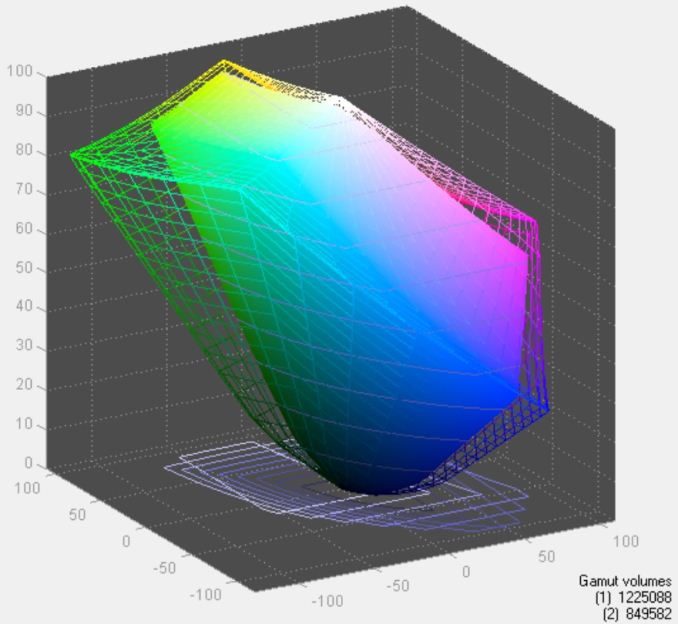
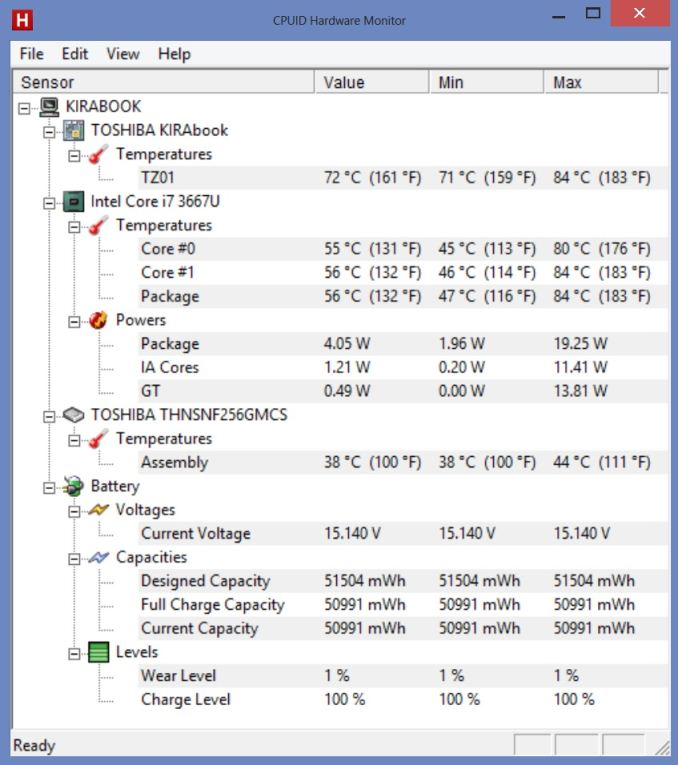








110 Comments
View All Comments
kevith - Thursday, May 9, 2013 - link
I think that´s spot on what Mac-buyers think. Every one of them, that I know, points out just that, again and again. Very well nailed!robinthakur - Monday, May 13, 2013 - link
Wow, a well reasoned argument, this site is not just catering to nerdy IT Types, the ultrabook is just a tool at the end of the day, not a toy to play with in and of itself. Apple's reputation for quality and customer service have ben hard won over many years, it is somewhat unfair to now expect PC manufacturers to offer the same when their margins are much less. I think the big difference now is that these machines cost as much as macs do, whereas in the past, you pretty much paid very little and got what you paid for.robinthakur - Monday, May 13, 2013 - link
Does "Posh" equal build quality? When you ape Apple's design so closely, then cheap out on the materials, do they think people won't notice? There is a time in a potential customer's lifecycle where they evaluate what choices are out there, and solicit purchase advice from knowledgeable sources. If you are in the market for an ultrabook, the main competition is the MacBook Air, which is comfortably still the biggest selling ultrabook, not the PC variants. I personally know loads of people that bought MBA's and then run windows on them, usually they present a lot, and being able to kit it out with 8GB of ram was a big deal at the time, even if you are constrained to dual core CPUs.sxr7171 - Sunday, May 19, 2013 - link
Having recently switched back to Windows for hardware reasons (Nec Lavie Z - lighter than any Macbook), I agree simply based on that touchpad. Apple touch technology is miles ahead of anything Ive used on Windows. I'm still playing with these synaptics settings and I'm not anywhere close to the "out of the box" feel of a Mac's touchpad feel. I really like the Thinkpad trackpoint on Windows but no touchpad can compare to the Apple touchpad.Also this OS is confused. Does it belong a laptop or tablet, I can't figure it out. It generally sends you back to the old Windows settings screen for any major settings changes. Apps launch off the start screen into desktop mode anyway. The RT mode has the same apps optimized for touch input.
Also Windows still hasn't improved the overall amount of effort it takes set the machine up the way that one likes. A Mac out of the box takes about an hour to get to how I like it. A Windows machine takes 6-8 hours if not more. Some things are terrible like setting up a Wi-Fi priority list requires you to get into terminal. The time needed to research and implement things is much higher on Windows. I've had to run some Google Searches for Mac also but far fewer and the it rarely if ever necessitates going into Terminal.
All in all I couldn't agree more that competitors of Apple have to undercut Apple on price. The only exception would be if they have very compelling hardware features that Apple doesn't have and those are few and far between.
happycamperjack - Thursday, May 9, 2013 - link
I think you missed the point. Retina 13 can run both Windows and OSX. But this laptop can only run windows. So it is a subset of Retina 13, therefore it should cost less.wendoman - Thursday, May 9, 2013 - link
But Macbooks runs Windows very bad usually. Poor battery life, bad drivers etc.I don't know about Intel only GPU Macs, but Macbooks with discrete GPU can't switch graphics and drain battery.
lukarak - Thursday, May 9, 2013 - link
You can always run it in VMWare. Which you can't easily do with OS X on WindowsKPOM - Thursday, May 9, 2013 - link
I run Windows 7 on my 13" rMBP and it works pretty well. Sure, Apple doesn't prioritize their WIndows drivers, but it is certainly doable. You are right that battery life takes a hit, though. Sometimes replacing the Boot Camp drivers with the native Intel drivers helps.SirKronan - Saturday, May 11, 2013 - link
I did this with my video card drivers on my MBP and noticed not only an improvement in battery life (albeit a small one) but a significant difference in performance and stability.nathanddrews - Thursday, May 9, 2013 - link
This laptop could probably run OSX. Hackintosh style.